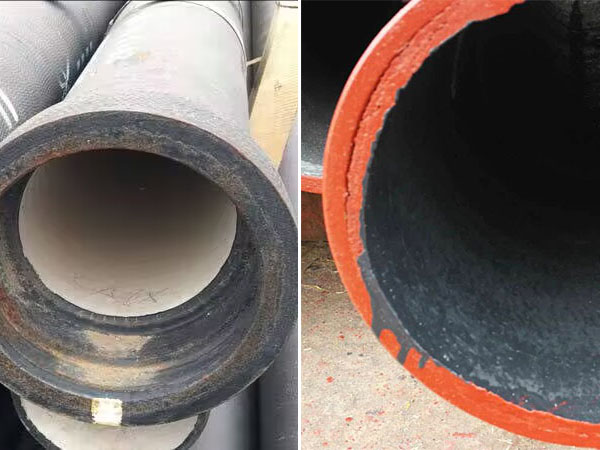In the field of pipeline transportation, to balance wear resistance, corrosion resistance and economy, different materials of linings are often added to the inner walls of steel pipes. Ceramic linings and
Cement linings are two relatively common types of linings in pipeline transportation. They differ in structure, performance, applicable scenarios, advantages and disadvantages, etc.
What are Ceramic lined steel pipe and Cement lined steel pipe?
Ceramic lined steel pipe is made up of steel pipe and a ceramic lining. The inner ceramic lining is Corundum (Mohs ~9, hardness up to HV 1100-1500, equivalent to HRC 90-98), with a transition layer in the middle for enhanced bonding, and the outer steel provides excellent strength and toughness.
The manufacturing methods of ceramic-lined steel pipes include centrifugal casting and high-temperature sintering. Thermal spraying SHS self-ignition method Bonding method, etc.
Cement lined steel pipe is a steel pipe with a layer of cement mortar coated on the inner side (the thickness varies depending on the standard) to meet standards such as AWWA C205/C602, ANSI/NSF-61 and ISO 4179.
The manufacturing process of Cement lined steel pipe mainly involves pouring and curing under constant temperature and humidity, and the surface of the steel pipe is inspected by visual inspection or ultrasonic inspection methods.

Performance comparison
Ceramic lined steel pipe
Abrasion resistance: Extremely high abrasion resistance, ceramic lining provides excellent protection against abrasive particles, abrasion life is more than 10-20 times that of ordinary steel pipe, abrasion volume is reduced to 0.0022 cm³.
Corrosion resistance: The ceramic layer can effectively enhance the corrosion resistance, has stable chemical properties, and offers good resistance to corrosive media such as acids, alkalis, and salts.
High-temperature performance: It has strong high-temperature resistance, stable thermal shock, and the ceramic lining can withstand temperatures ranging from -50℃ to 700℃. It is widely used in power plants, cement plants, and mining industries.
Mechanical properties: The outer steel pipe can provide sufficient strength and toughness, but the inner ceramic layer is brittle and sensitive to impact.
Cement lined steel pipe
Wear resistance: It has poor wear resistance and is not suitable for environments with high abrasive particles.
Corrosion resistance: It can effectively resist the intrusion of chloride ions and the corrosion caused by iron pipes, and can protect water quality.
High-temperature performance: It is highly sensitive to temperature. Cracks are prone to occur when the temperature difference exceeds 60℃.
Fluid resistance: The inner wall is smooth, which can effectively prevent deposition and has a relatively low flow resistance.
Mechanical properties: The inner lining has a compressive strength of 20-40 MPa and good crack resistance, but the material itself is relatively brittle.
Applicable scenarios
Ceramic-lined pipe
Mining: Used for conveying abrasive slurries.
Power plant: Processes pulverized coal and other by-products.
Cement industry: Pneumatic conveying of fine materials such as clinker dust.
Chemical treatment: Suitable for pipelines exposed to corrosive chemicals.
Cement lined steel pipe: Widely used in municipal water supply, fire protection pipe networks, cooling water and sewage discharge.
Comparison of advantages and disadvantages
Ceramic-lined pipe
Advantages:
Wear-resistant, corrosion-resistant, heat-resistant, with a smooth inner wall and low flow resistance, reducing maintenance and energy consumption.
Long service life, lightweight structure and convenient installation.
It is cost-effective from a long-term economic perspective.
Disadvantage:
High initial investment;
The ceramic layer is fragile. Impact or sudden temperature changes may cause it to crack.
Internal examination and repair are relatively complex.
Cement lined steel pipe:
Advantages:
Economical in cost and in compliance with drinking water hygiene standards;
Effective anti-corrosion and low flow velocity resistance;
Suitable for large-scale pipeline network projects.
Disadvantage:
It is highly brittle and prone to cracking due to temperature differences and external forces.
Heavy consumption increases transportation and installation costs;
Not suitable for highly abrasive media.
Summary and suggestions
If transporting high-abrasive, highly corrosive or high-temperature media, it is recommended to choose ceramic-lined steel pipes, especially in the fields of mining, metallurgy, power and chemical engineering, where their durability and economy are remarkable.
If it is used in medium and low pressure common water systems (urban water supply, fire protection, cooling water, etc.), Cement lined steel pipe can be selected
It has low cost, complies with standards and is relatively easy to maintain.
